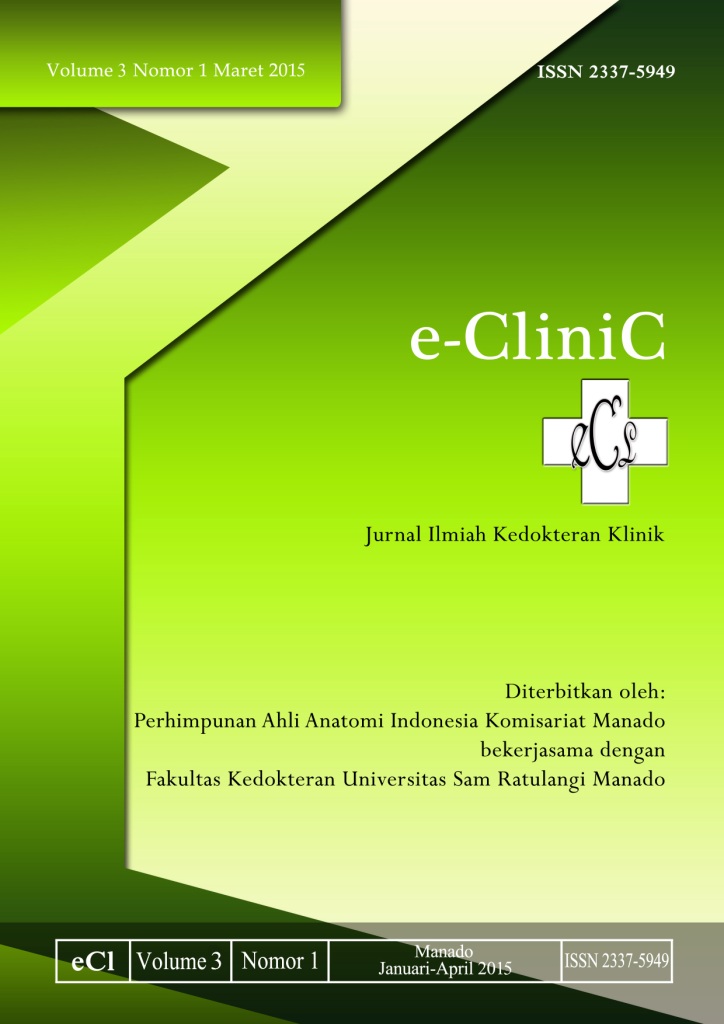HUBUNGAN ANTARA RATIO NETROFIL LIMFOSIT DENGAN KLASIFIKASI RISIKO PADA LEUKEMIA LIMFOBLASTIK AKUT
DOI:
https://doi.org/10.35790/ecl.v3i1.6757Abstract
Abstract: Leukemia is a primary malignant disease that has dangerous risk of death. Acute lymphoblastic leukemia is a cancer mostly diagnosed in children. Prognostic assessment of acute lymphoblastic leukemia depend on the type of the risk, which is classified into high risk or standard risk. Prognostic assessment of acute lymphoblastic leukemia can be determined by some criteria and one of them is by observing the total of leukocyte in laboratory test. Reduction of neutrophil and increased of limphocyte mostly in ALL. The purpose of this study understanding the relationship between neutrophil to lymphocyte ratio and the risk classification of acute lymphoblastic leukemia. The research is an analytical retrospective using survey method. The research samples are patient with acute lymphoblastic leukemia who were admited at pediatric department of RSUP Prof. Dr. R. D. Kandou Manado during the period of January 2010-October 2014. Resources were taken from the medical records of RSUP Prof. Dr. R. D. Kandou Manado. Result: From the 46 samples, there are 39 samples that suffered from ALL at the age of 1-10 years old and most of them are boys. Twenty four samples are classified as high risk and 22 are classified as standard risk. According to the bivariate analysis, value of p=0,432>0,05. Conclusion: There is no relationship between neutrophil to lympocyte ratio and the risk classification for acute lymphoblastic leukemia.
Keywords: acute lymphoblastic leukemia, high risk, standard risk, neutrophil to lymphocyte ratio
Abstrak: Leukemia merupakan penyakit keganasan primer yang memiliki risiko berbahaya menyebabkan kematian. Leukemia limfoblastik akut (LLA) adalah penyakit keganasan yang paling sering didiagnosis pada anak-anak. Penilaian prognosis leukemia limfoblastik akut tergantung pada jenis risiko yang diderita, risiko tinggi atau risiko standar. Penilaian prognosis pada leukemia limfoblastik akut ditentukan oleh beberapa kriteria salah satunya melihat jumlah leukosit dari hasil pemeriksaan laboratorium. Penurunan jumlah netrofil dan peningkatan jumlah limfosit sering terjadi pada LLA. Tujuan penelitian ini untuk mengetahui hubungan ratio netrofil limfosit dengan klasifikasi risiko pada leukemia limfoblastik akut. Penelitian ini bersifat analitik dengan metode survei retrospektif terhadap pasien dengan penyakit leukemia limfoblastik akut di Bagian Ilmu Kesehatan Anak RSUP Prof. Dr. R. D. Kandou Manado selama periode Januari 2010-Oktober 2014. Sumber data didapatkan dari rekam medik di RSUP Prof. Dr. R. D. Kandou Manado. Hasil: didapatkan dari 46 sampel terdapat 39 sampel yang menderita LLA pada usia 1-10 tahun, laki-laki lebih banyak menderita LLA, 24 sampel dengan kelompok risiko tinggi dan 22 sampel dengan kelompok risiko standar. Hasil analisis bivariat menunjukkan nilai p=0,432>0,05. Simpulan: Tidak ada hubungan antara ratio netrofil limfosit dengan klasifikasi risiko pada leukemia limfoblastik akut.
Kata kunci: Leukemia limfoblastik akut, risiko tinggi, risiko standar, ratio netrofil limfosit.
Downloads
Published
How to Cite
Issue
Section
License
COPYRIGHT
Authors who publish with this journal agree to the following terms:
Authors hold their copyright and grant this journal the privilege of first publication, with the work simultaneously licensed under a Creative Commons Attribution License that permits others to impart the work with an acknowledgment of the work's origin and initial publication by this journal.
Authors can enter into separate or additional contractual arrangements for the non-exclusive distribution of the journal's published version of the work (for example, post it to an institutional repository or publish it in a book), with an acknowledgment of its underlying publication in this journal.
Authors are permitted and encouraged to post their work online (for example, in institutional repositories or on their website) as it can lead to productive exchanges, as well as earlier and greater citation of the published work (See The Effect of Open Access).







